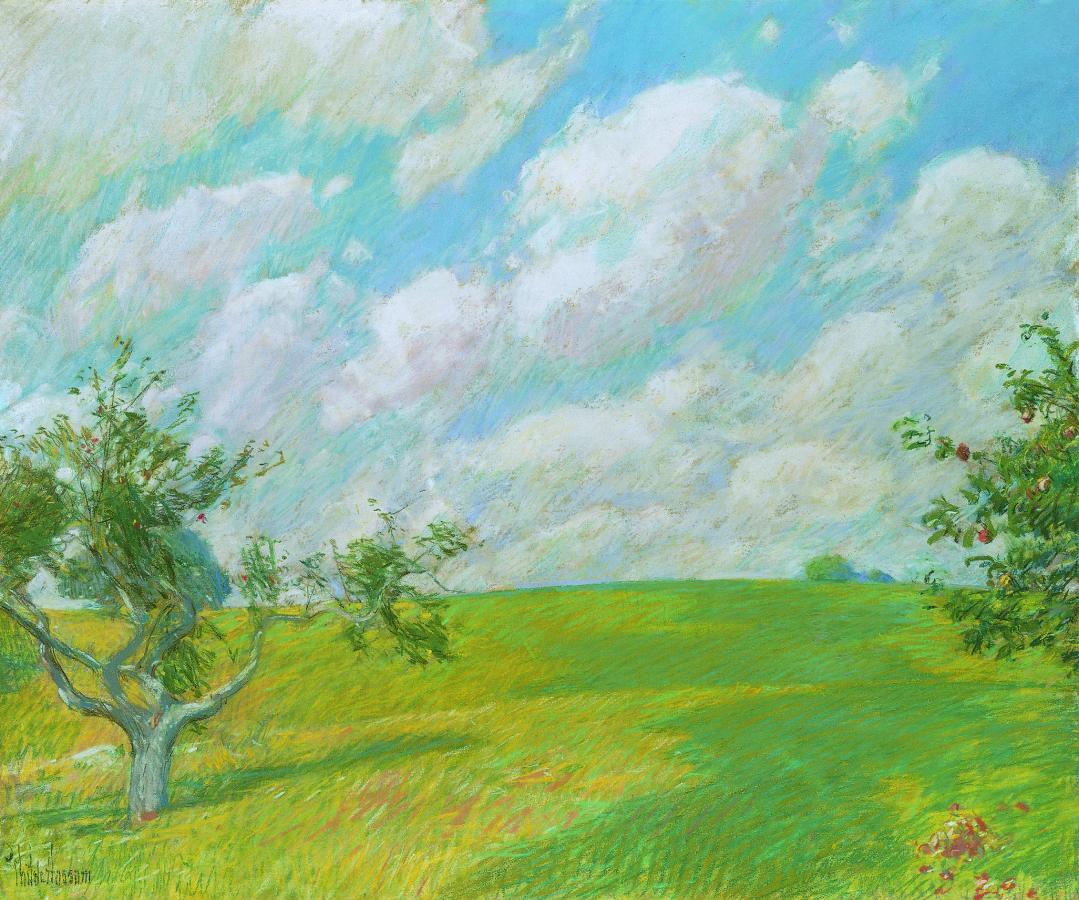Hassam, Childe (1859-1935)
September Clouds
c.1891
Pastel on canvas, 50.8 x 61 cm
Museo Thyssen-Bornemisza, Madrid
©Carmen Thyssen Collection
After three years study in Europe, Childe Hassam returned to the United States in the fall of 1889. The following spring he exhibited in the fourth and last exhibition of The Society of Painters in Pastel, which promoted the virtues of a medium that was becoming popular in America. The Society, formed in 1882, held its first exhibition in New York in 1884, a year before the Société des Pastellistes was organised in Paris, and four years before the first exhibition of the London Pastel Society in 1888. Pastel, it was felt, was the perfect medium for capturing the “unsubstantial mood of nature”; it “can seize such evanescent, shy effect, can intimate such inimitable textures, can elaborate such bewitching, rare tonalities, and such aerial or such audacious schemes of color […]”, wrote a reviewer of the Society’s first exhibition.
The effusion of nature was a favourite subject for Hassam, and although pastels are a small part of his total oeuvre, the artist used the medium to great success in a number of flowering and arboreal landscapes. The transitory nature of the fugitive blossom of leaf is captured by Hassam in such pastels as Poppies, Isles of Shoals, 1890 (Mr. and Mrs. Raymond Horowitz Collection); Poppies, Isles of Shoals, 1891 (Private collection); Summertime, 1891 (Private collection); as well as in September Clouds. As his early biographer, Adeline Adams, ironically noted: “This most masculine of artists delighted in creating color designs from the most fragile, evanescent elements. He chooses a blossoming fruit tree, the shimmer of birches, a vine, a veil of mist […]”.
September Clouds is one of a number of pastels Hassam made at Lexington, Massachusetts, during September and October in 1891. Lexington, situated eleven miles from Boston with a population of a little over three thousand, was venerated for the role it played in the American Revolutionary War. The area was described by a 19th-century historian as “generally uneven, furnishing a pleasant variety of hill and dale” with “a warm and productive soil, well adapted to grass and fruit trees. “September Clouds was among the nineteen pastels that Hassam exhibited in Boston at Doll and Richards that November, which were almost exclusively of Lexington or neighbouring towns. The pastel was highly praised by the critics. The review in the Boston Daily Advertiser, under the heading, “Mr. Hassam’s Work, ‘September Clouds’, A Good Example”, characterised the pastel as “a simple but poetic representation of a pleasing subject”, while the critic for the Boston Evening Transcript described it as “a sunny midsummer [sic] landscape, with a fine blue and white sky, and cloud-shadows meandering over the greensward”.
Critics also noted that these landscapes exhibited certain eccentricities of the artist. Unlike Hassam‘s previous images of apple and pear orchards, often in bloom, September Clouds, like Summer in the Park (Private collection), which was also done at Lexington that year, is radical in composition. An apple tree frames the landscape on the left, while another tree on the right, bearing fruit almost ready for harvest, is abruptly cut off in the manner of Japanese prints. The centre of the composition remains provocatively empty, showing only the shadows of cumulus clouds overhead. “Such joyous pictures”, it was noted, “indicate a spirit of healthy enjoyment in the production, a gusto on the part of the artist, who convinces his public by every crayon-stroke that it is a fine thing to live, to be young, to be a painter […] and above all to make […] such artistic pictures”.
Kenneth W. Maddox (T-B)
